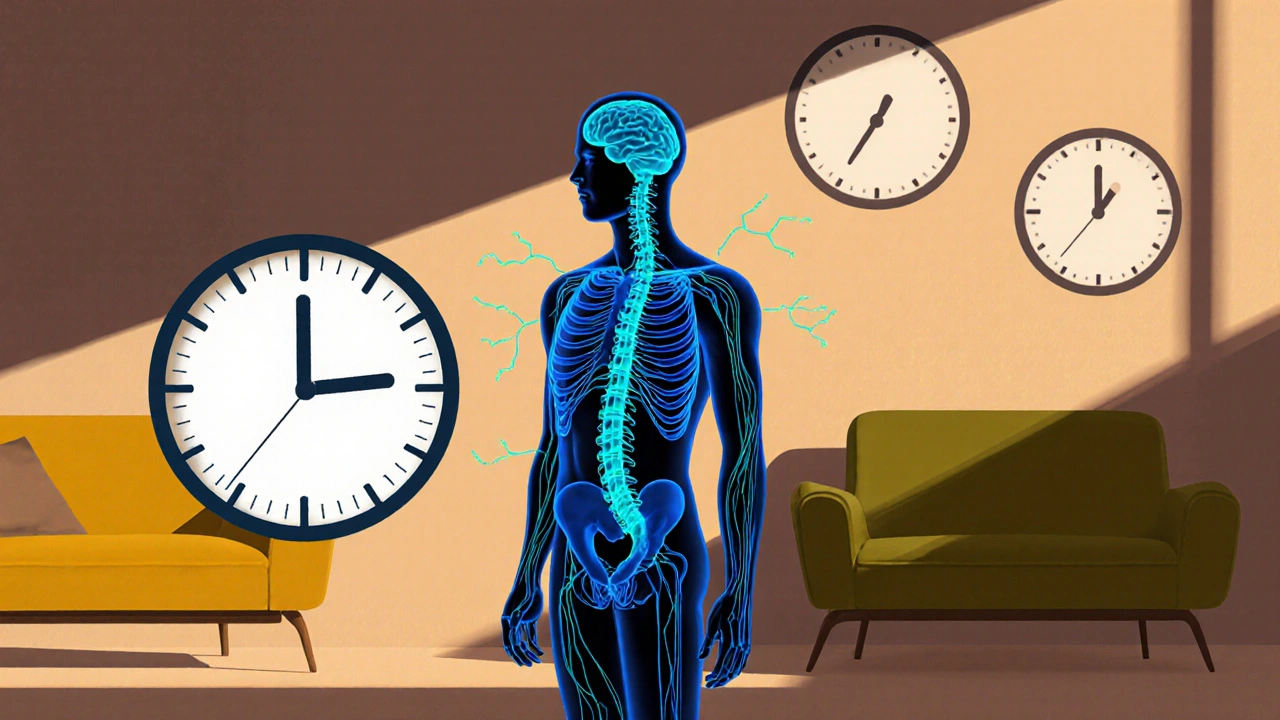Muscle Relaxant Comparison Tool
Which Muscle Relaxant Is Right for You?
Answer a few questions to find the most appropriate muscle relaxant alternative to Zanaflex based on your specific situation. This tool uses information from the article to help you have a more informed discussion with your doctor.
How This Tool Works
This tool analyzes your responses using information from the article to recommend muscle relaxant options that best match your needs. It considers:
- Type of muscle spasm (chronic vs acute)
- Your specific side effect concerns
- Other important factors like cost and age
Remember: This is informational only. Always consult with your doctor before changing medications.
Zanaflex (tizanidine) is a muscle relaxant commonly prescribed for short-term relief of muscle spasms caused by conditions like multiple sclerosis or spinal cord injuries. But it’s not the only option. If you’ve been prescribed Zanaflex and are wondering whether there’s a better fit for your body, lifestyle, or side effect tolerance, you’re not alone. Many people switch between muscle relaxants based on how well they work, how they make them feel, and whether the side effects are manageable.
How Zanaflex (Tizanidine) Works
Zanaflex acts on the central nervous system, specifically targeting alpha-2 receptors in the brain and spinal cord. This reduces the nerve signals that cause muscles to tighten up. It starts working within about 1 hour and lasts 3 to 6 hours. That means it’s often taken two to three times a day when muscle spasms are most disruptive - like in the morning or before bed.
Unlike some other muscle relaxants, Zanaflex doesn’t directly relax muscles. Instead, it calms the overactive nerve pathways that trigger spasms. That’s why it’s often used for chronic conditions where spasms are caused by neurological damage, not just strain or injury.
Common Side Effects of Zanaflex
Almost everyone who takes Zanaflex experiences at least one side effect. The most common ones are:
- Drowsiness (up to 60% of users)
- Dry mouth (about 40%)
- Dizziness or lightheadedness
- Weakness or fatigue
- Low blood pressure
Some people feel so sleepy they can’t drive or operate machinery. Others report a strange, metallic taste in their mouth. These effects tend to fade after a few days as the body adjusts - but not always. If drowsiness lasts more than a week or interferes with daily life, it’s worth talking to your doctor about alternatives.
Alternative 1: Baclofen
Baclofen is one of the most common alternatives to Zanaflex. Like tizanidine, it works on the central nervous system - but it targets GABA-B receptors instead. It’s often preferred for people with spinal cord injuries or cerebral palsy because it helps reduce spasticity over longer periods.
Compared to Zanaflex, baclofen tends to cause less drowsiness, but it can lead to other issues:
- Muscle weakness
- Nausea
- Confusion or mood changes
- Withdrawal symptoms if stopped suddenly (seizures, hallucinations)
Baclofen is usually taken three to four times a day. Some people use an implanted pump for continuous delivery, which helps avoid the peaks and crashes of oral doses. It’s also available as a generic, making it cheaper than Zanaflex in many cases.
Alternative 2: Cyclobenzaprine (Flexeril)
Cyclobenzaprine is the most prescribed muscle relaxant in the U.S. It’s often used for acute, short-term muscle pain - like after a back strain or whiplash. Unlike Zanaflex, it’s not typically used for chronic neurological conditions.
It works similarly to tricyclic antidepressants, affecting brain chemicals that control muscle movement. That’s why its side effects resemble those of older antidepressants:
- Extreme drowsiness (more than Zanaflex)
- Blurred vision
- Constipation
- Dry mouth
- Heart palpitations in older adults
It’s usually taken for only 7 to 10 days because of its sedating effects and potential for dependency. People over 65 are often advised against it due to increased risk of falls and confusion. If you need something for daily use over weeks or months, cyclobenzaprine may not be the best fit.

Alternative 3: Methocarbamol (Robaxin)
Methocarbamol is another option, especially for people who want a muscle relaxant with less brain impact. It’s often used in emergency rooms or for acute injuries because it’s considered one of the safest options for short-term use.
Its main advantage? Fewer cognitive side effects. Most people don’t feel as groggy on methocarbamol as they do on Zanaflex or cyclobenzaprine. But it’s not as strong for severe spasticity.
Side effects include:
- Dizziness
- Nausea
- Blurred vision
- Dark urine (harmless, but can alarm patients)
It’s often taken four times a day. The dose can be high - up to 6,000 mg daily - which makes it less convenient than once- or twice-daily options. It’s also not ideal for people with kidney problems.
Alternative 4: Diazepam (Valium)
Diazepam is a benzodiazepine, not a traditional muscle relaxant - but it’s frequently prescribed off-label for muscle spasms. It works by enhancing GABA activity, which calms nerve signals throughout the body.
It’s effective for spasms tied to anxiety or stress, and it can help with sleep. But it comes with serious risks:
- High potential for dependence
- Memory issues and confusion
- Increased fall risk in older adults
- Withdrawal symptoms including seizures
Because of these dangers, doctors usually reserve diazepam for short-term use or when other options have failed. If you’re already taking sleep aids, opioids, or antidepressants, combining them with diazepam can be dangerous.
Alternative 5: Non-Drug Options
Medication isn’t the only path to relief. Many people find long-term improvement through:
- Physical therapy: Stretching and strengthening exercises reduce spasticity over time.
- Heat or cold therapy: Warm baths or ice packs can ease tight muscles.
- Massage or acupuncture: Some studies show reduced muscle tension after regular sessions.
- Botox injections: For localized spasms (like in one leg or arm), Botox can block nerve signals directly at the muscle.
- Medical cannabis: In some regions, cannabinoids like CBD or THC are approved for spasticity in MS patients. Research shows they can reduce spasms and improve sleep.
These options don’t replace medication for everyone - but they can reduce the dose you need, or even eliminate it entirely if your condition is mild.
Which Alternative Is Right for You?
Choosing between Zanaflex and its alternatives depends on three things: your condition, your lifestyle, and your tolerance for side effects.
If you have chronic neurological spasticity - like from MS or spinal injury - baclofen or Zanaflex are your top choices. Baclofen may be better if you need all-day control without heavy sedation.
If your spasms are acute - from a pulled muscle or recent injury - methocarbamol or cyclobenzaprine may work better. But don’t use cyclobenzaprine for more than 10 days.
If you can’t tolerate drowsiness - maybe you work, drive, or care for children - methocarbamol or non-drug options like physical therapy are safer. Avoid diazepam unless other options have failed.
If cost is a concern - generic baclofen and methocarbamol are often cheaper than Zanaflex. Cyclobenzaprine is also inexpensive, but its side effects make it less ideal for long-term use.
Things to Watch Out For
Some interactions can be dangerous:
- Never mix Zanaflex with alcohol, opioids, or sleep medications - it can cause dangerous breathing problems.
- Antibiotics like ciprofloxacin can increase Zanaflex levels in your blood, leading to overdose symptoms like extreme drowsiness or low blood pressure.
- Fluvoxamine (an antidepressant) can also raise Zanaflex levels significantly.
Always tell your doctor about every supplement, herb, or over-the-counter pill you take. Even something as simple as St. John’s Wort can interfere with how your body processes muscle relaxants.
When to Talk to Your Doctor
You should reach out if:
- Your muscle spasms aren’t improving after two weeks on Zanaflex.
- You’re too drowsy to function during the day.
- You’ve developed new symptoms like confusion, slow heartbeat, or fainting.
- You want to stop taking Zanaflex - never quit cold turkey. Tapering is needed to avoid rebound spasms or high blood pressure.
Your doctor may adjust your dose, switch you to another medication, or add a non-drug therapy. Many people find relief by combining two approaches - like taking a low dose of baclofen with daily stretching.
Is Zanaflex stronger than baclofen?
It depends on the person. Zanaflex works faster and is more sedating, which some people prefer for nighttime use. Baclofen provides longer-lasting relief and is often better for daytime use. Studies show both reduce spasticity similarly, but baclofen has fewer cognitive side effects for most users.
Can I take Zanaflex and cyclobenzaprine together?
No. Combining them greatly increases the risk of extreme drowsiness, low blood pressure, and slowed breathing. Doctors avoid this combination unless under strict supervision in a hospital setting.
Does tizanidine help with nerve pain?
Not directly. Zanaflex treats muscle spasms caused by nerve damage, but it doesn’t calm nerve pain itself. For nerve pain (like burning or tingling), medications like gabapentin or pregabalin are more effective. Some people take both - one for spasms, one for pain.
How long does it take for Zanaflex to leave your system?
Zanaflex has a short half-life of about 2.5 hours, meaning most of it is gone within 12 hours. But its effects on the nervous system can linger, especially if you’ve been taking it for weeks. Withdrawal symptoms like rebound spasms or high blood pressure can appear within 24 to 48 hours after stopping.
Are there natural alternatives to Zanaflex?
Yes. Magnesium supplements, CBD oil, and regular stretching have shown promise in reducing muscle spasms. One 2023 study found that people with MS who did daily stretching and took 400 mg of magnesium saw a 30% reduction in spasm frequency. These aren’t replacements for medication in severe cases, but they can reduce the dose needed.
Next Steps
If you’re considering switching from Zanaflex, start by tracking your symptoms for a week. Note when spasms happen, how bad they are, and how much drowsiness you feel. Bring this log to your doctor. They can help you compare options based on your real-world experience, not just textbook data.
Don’t switch on your own. Even a small change in dosage can cause serious side effects. Work with your provider to find the right balance - whether that’s a different pill, a lower dose, or adding physical therapy. Many people find relief without ever needing to rely on muscle relaxants long-term.


Write a comment